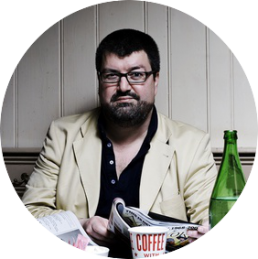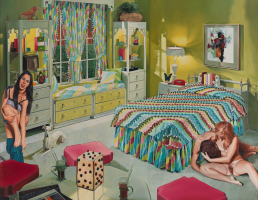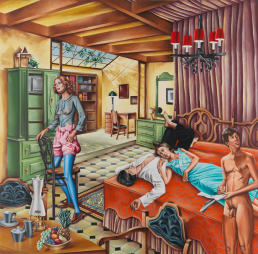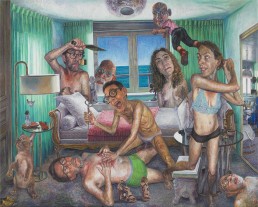Articles and Features:
Mark Greenwold"And Now What?!"
Garth Greenan Gallery - New York

Christian Viveros-Fauné | Kulchur Vulture
About: Viveros-Fauné is Artland’s inaugural Chief Critic and the contributor of this regular column. Based in New York City, he writes primarily about exhibitions and the cultural landscape there. His articles also often feature Artland’s revolutionary and market leading Artland 3D, virtual exhibition tours that enable the viewer to pay compelling virtual visits to actual exhibition spaces in support of the texts. This edition visits Garth Greenan Galley in NY for the Mark Greenwold exhibition, ‘And Now What?!’.
Does the shame of being human ever cease? Not for painter Mark Greenwold, whose latest exhibition of paintings and drawings at Garth Greenan bring together forty-four years of disturbing, perversely detailed, fever dream pictures that feature sex, old age, self-portraiture, the discomfort of friends, and several lifetimes of embarrassing analysand revelations the septuagenarian artist depicts with a brush the size of a needle.
Greenwold’s laboriously meticulous realism is New York legend. His first Manhattan solo show consisted of just one canvas that featured Manson-family-inspired sexual violence. Village Voice critic Lucy Lippard savaged it as “the item that made me maddest last season.” Another fastidiously obsessive work from the same era titled Bright Promise (for Simon)—at seven feet tall, it’s the largest canvas in the current show—featured explicit sex, a Better Homes & Gardens boudoir, and a bedspread with 1,200 precisely rendered chenille balls. The artist called it “the biggest miniature in art history”—it took him four whole years to complete.

Greenwold’s present exhibition consists of that picture and eleven other canvases made between 1964 and 2018. In painting after painting, Greenwold’s trigger-warning content gives way to something weirder: the precision he uses to portray his awkward narrative scenes. The Cleveland-born New Yorker consistently wields his brushes like a jeweller—his figures look as if they’ve been arranged inside his interiors with tweezers. Look closer and you’ll see that each one is made up of hundreds if not thousands of diminutive strokes. One mashup description for the artist’s delirious realism: Piero della Francesca meets Robert Crumb at a Manhattan co-op key party.
Consisting of pocket-sized renditions of people in various states of undress occupying cramped, apartment-like spaces, Greenwold’s paintings feature male and female figures mugging gawkily, even lewdly inside well-appointed bedrooms, living rooms and libraries. Arranged with no recognizable hierarchy, his interiors flow into one another according to what may be called Freudian perspective. Take both the 1971 painting Spanish Mediterranean Bedroom and 2017’s A Magic Summer. Both canvases depict loads of details large and small—flowing drapery, chandeliers, mirrors, patterned duvets, semi clothed women, tighty-whities and full frontal male nudity—and each receive equal amounts of exquisite painterly attention when it comes to color, surface and texture.


The opposite of Eric Fischl’s oil-on-canvas idylls of genteel art-world types lording it over mere mortals in East Hampton, Greenwold’s scenes instead resemble Tony Soprano’s psychosexual nightmare in season one, episode one of that ur-American crime drama: when the Jersey Don turns his Phillips-head belly button counterclockwise, his penis falls off. Greenwold’s consistently off-kilter mise-en-scène also enacts a burlesque of intimism as practiced by moody domestic painters like Pierre Bonnard and Édouard Vuillard. Gone is their nostalgia-inducing broken color technique; in its place, Greenwold proposes the all-over crispness film director Terry Gilliam (of Brazil fame) christened “deep focus.”
A product of the artist’s habit of covering up large parts of his paintings while he works on specific sections—a practice that led painter Lisa Yuskavage to accuse Greenwold of playing exquisite corpse with himself—the artist’s method results in cut-up compositions with the stitching erased. A perfect example is the show’s title painting, And Now What?! A canvas that sports no less than four nude self-portraits, as well as depictions of female and male friends, a black cat, a wolfish dog, and a grinning skull, the painting unveils much of the dread and anxiety associated with the artist’s life, but seen through an electron microscope.

Relevant sources to learn more:
Gallery
Garth Greenan Gallery,
New York
Opening Times
Tue – Sat
11 am – 6 pm
Address
545 West 20th Street,
New York,
NY 10011
info@garthgreenan.com
+1 212 929 1351